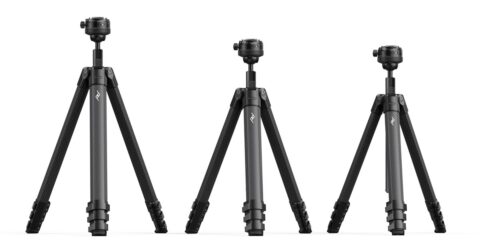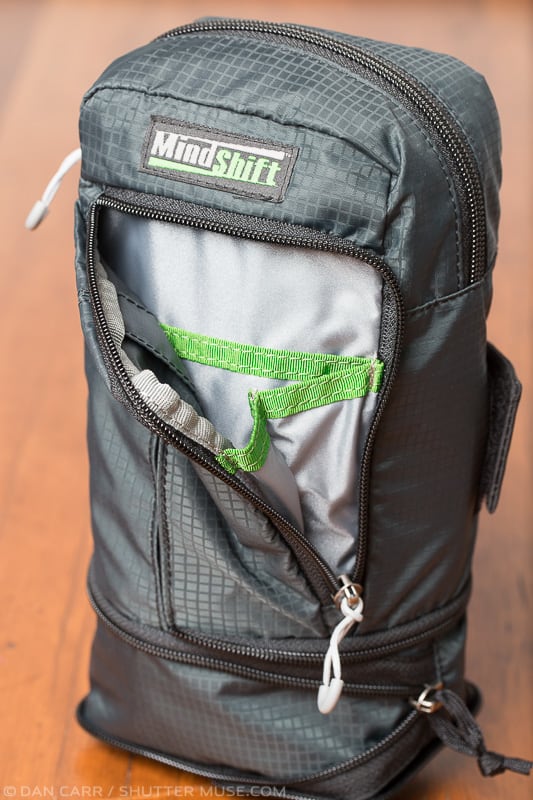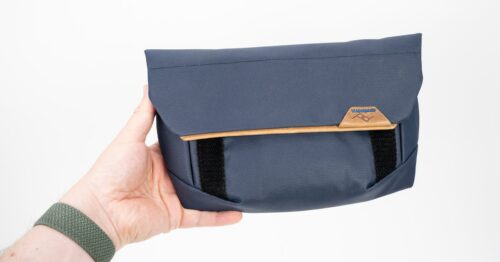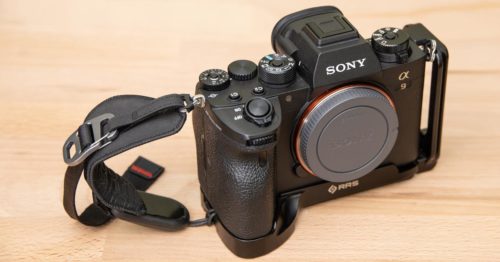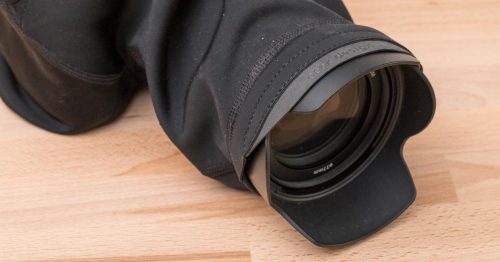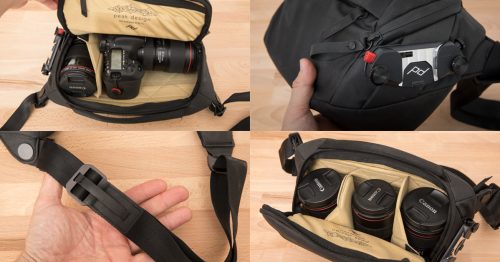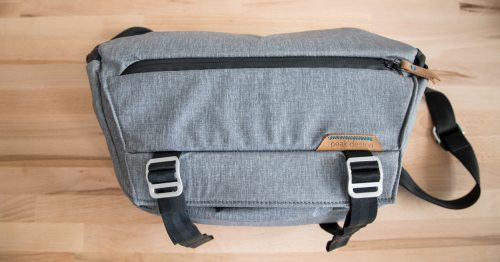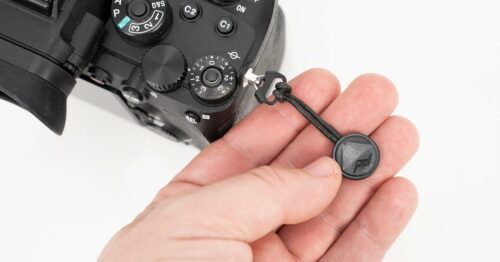I’ve used all kinds of Peak Design products in the last few years, and always been impressed with the bomber construction of their camera bags so I thought I’d purchase one of the Range Pouches to check it out and see how it compares to their other products. The Range Pouch is available in three different sizes and starts at $35 for the small size, $40 for the medium and $45 for the large. There’s really no rules about what you can carry in the Range Pouch, although obviously most people will be thinking about putting a lens in it, or perhaps a small camera such as a Fuji X100 or other similarly sized camera with a small fixed lens.
Like all of Peak Design’s other bags, the material is very impressive. DWR impregnated weatherproof 500D Kodra shell with high-density padding to be precise. In practice, this means it is highly resistant to rain, and feels incredibly tough. Seriously, it feels like I could stab this thing with my Leatherman and it would just glance off it. Peak Design’s material choices have always been one of their most impressive features for me.

The Range Pouch has a number of interesting features that are worth underlining, the first of which is the inclusion of Anchor Links, allowing you to attach a quick-release Peak Design shoulder strap. The Leash or the Slide Lite would make the most sense, both of which also happen to be my camera straps of choice for my Canon and Fuji cameras. I think the larger Slide strap would be overkill for this small pouch.
On the back of the pouch you’ll also find a small label that allows you to indicate the contents of the pouch if you are using more than one, and you’ll also find the belt loop ,which does open up, allowing you to slide it onto a belt without removing said belt.
When I first looked inside the Range Pouch I was quite surprised at what I saw! I had expected it to be a single internal pocket, but actually there are two thin internal dividers that split the pouch into three. In reality, if you put a lens into the pouch, you can’t really access these other two pockets, but if you’re using it to store smaller items than it allows you some organization. The central divider also folds down onto a lens in the central pocket, acting as protection if you want to stack two lenses on top o each other. It’s all very clever, and if you don’t need, it, hook-and-loop keeps the dividers hidden away so you won’t even notice them.
Size and shape of the Range Pouch is a bit odd, and definitely worth mentioning. I got the medium size, and I can just about squeeze in my Canon 24-105 or Canon 16-35. It’s tight enough though, that it becomes a pain in the ass to remove the lens, and I wish I had gone with the larger size. PD’s website suggests either the medium or large case for these lenses, but these cases are cut tightly so I would recommend getting the larger size of whichever two Peak Design recommends for you.
As the photos show, the pouch is also tapered at the bottom, and I genuinely can’t find a reason for this. What I’ve found in reviewing almost all of Peak Design’s products, is that there’s usually one or two design choices on them that are definitely form over function, and this appears to be the case here as well. The tapered bottom of the pouch is wasted size and space when you are mostly putting cylindrical items in it. It also means you can’t stand the case up on any surface. With all my other similar cases, I often leave lenses in them and put them on a shelf or in a cupboard. You can’t do that with the Range Pouch.
Video Review
Peak Design Range Pouch Vs. Field Pouch
The Field Pouch (Field Pouch review) has a much more horizontal design to it, whereas the Range Pouch would be described as vertical. As a result, the opening of the Field Pouch is considerably larger, making it easier to rummage around in for smaller items. The Field Pouch also has 6 small internal pockets, which again make it a better option for small trinkets. The Field Pouch is $40, which is the same price as the medium sized Range Pouch.
Overall, I personally prefer the Field Pouch because I think it’s a more versatile option. I can put a small camera in it, a medium sized lens or a whole bunch of small accessories. Even though the Range Pouch is designed to hold lenses, as I have pointed out, it’s a tight fit width-wise for some common lenses such as the Canon 24-105 or Canon 16-35, whereas both of these lenses fit comfortably in the Field Pouch.

Other Options
I also use and love the MindShift Gear Lens Switch Case (review here). This bag won’t match your other Peak Design gear if that’s the style you like, but it does offer the versatility of a pop-down design. This means you can use it with small and medium lenses, or extend it to accommodate a 100-400 or 70-200. It doesn’t look as high-end as the Peak Design Range Pouch, nor does it offer as much protection, but it does knock it for six when it comes to versatility.
If you’re looking for some lens cases to use for event photography, I’d recommend taking a look at the Think Tank pouch system, They have a complete range, which will work much better if you want to use multiple pouches to carry lots of lenses and potentially flashes and cameras on your belt. The Peak Design Range Pouch is much more suited to being used on its own, just as a single case to switch between a couple of lenses. One on camera and one in the pouch.
Conclusion
The Peak Design Range Pouch has the same incredibly rugged design that we have come to expect from their camera bags. I would expect this to last a lifetime even under extremely rough use in challenging environments, and I think this justifies the price of these lens/accessory holders. If you’re just looking for a small bag to carry some accessories in, such as batteries, cables and memory cards, I think the Field Pouch is a much better design because it has more internal pockets and a wider opening. The Range Pouch is a good option for smaller lenses, particularly mirrorless lenses, but I think the design could have been improved to work better with common DSLR lens sizes. For most medium sized DSLR lenses, you’ll be happier with the large size, even though it is suggested on the PD website that the medium size will also work. Overall, I would have preferred it if these had been a simpler cylindrical design that better fits a lens, instead of the tapered design which just creates wasted space at the bottom all the time, but you can’t fault the protection they offer, and the internal triple divider system is very clever. If you’re a Peak Design fan and already have some existing gear, such as shoulder straps and bags like the Everyday backpack, you’ll definitely be happy with the Range Pouch if you stick to my recommendation on sizing.


